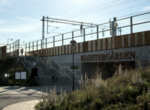Klostergårdens IP
20th-century establishments in Skåne CountyFootball venues in SwedenFootball venues in the Øresund RegionLunds BKSwedish sports venue stubs

Klostergårdens IP is an association football stadium in Lund, Sweden and the home stadium of Lunds BK.
Excerpt from the Wikipedia article Klostergårdens IP (License: CC BY-SA 3.0, Authors, Images).Klostergårdens IP
Stattenavägen, Lund Municipality
Geographical coordinates (GPS) Address External links Nearby Places Show on map
Geographical coordinates (GPS)
| Latitude | Longitude |
|---|---|
| N 55.695277777778 ° | E 13.18 ° |
Address
Klostergårdens idrottsområde (Klostergårdens idrottsplats)
Stattenavägen
222 28 Lund Municipality (Söder)
Sweden
Open on Google Maps











